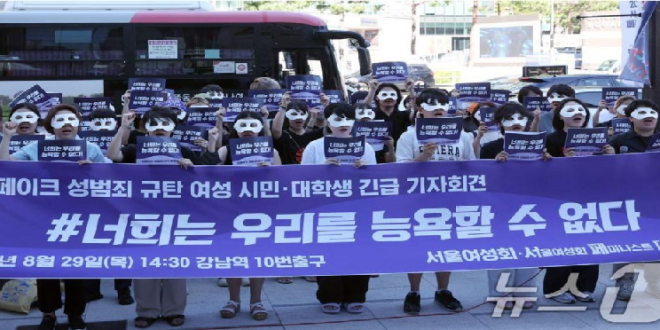04-09-2024
SEOUL: Last Saturday, a Telegram message popped up on Heejin’s phone from an anonymous sender. “Your pictures and personal information have been leaked. Let’s discuss.”
As the university student entered the chatroom to read the message, she received a photo of herself taken a few years ago while she was still at school. It was followed by a second image using the same photo, only this one was sexually explicit, and fake.
 Terrified, Heejin, which is not her real name, did not respond but the images kept coming. In all of them, her face had been attached to a body engaged in a sex act, using sophisticated deepfake technology.
Terrified, Heejin, which is not her real name, did not respond but the images kept coming. In all of them, her face had been attached to a body engaged in a sex act, using sophisticated deepfake technology.
Deepfakes, the majority of which combine a real person’s face with a fake, sexually explicit body, are increasingly being generated using artificial intelligence.
“I was petrified, I felt so alone,” Heejin told media.
Two days earlier, South Korean journalist Ko Narin had published what would turn into the biggest scoop of her career. It had recently emerged that police were investigating deepfake porn rings at two of the county’s major universities, and Ms Ko was convinced there must be more.
She started searching social media and uncovered dozens of chat groups on the messaging app Telegram where users were sharing photos of women they knew and using AI software to convert them into fake pornographic images within seconds.
“Every minute people were uploading photos of girls they knew and asking them to be turned into deepfakes,” Ms Ko told us.
Ko discovered these groups were not just targeting university students. There were rooms dedicated to specific high schools and even middle schools. If a lot of content was created using images of a particular student, she might even be given her own room. Broadly labelled “humiliation rooms” or “friend of friend rooms”, they often come with strict entry terms.
Ko’s report in the Hankyoreh newspaper has shocked South Korea. On Monday, police announced they were considering opening an investigation into Telegram, following the lead of authorities in France, who recently charged Telegram’s Russian founder for crimes relating to the app. The government has vowed to bring in stricter punishments for those involved, and the president has called for young men to be better educated.
 Telegram said it “actively combats harmful content on its platform, including illegal pornography,” in a statement provided to media.
Telegram said it “actively combats harmful content on its platform, including illegal pornography,” in a statement provided to media.
The media has viewed the descriptions of a number of these chatrooms. One calls for members to post more than four photos of someone along with their name, age and the area they live in.
“I was shocked at how systematic and organized the process was,” said Ko. “The most horrific thing I discovered was a group for underage pupils at one school that had more than 2,000 members.” In the days after Ko’s article was published, women’s rights activists started to scour Telegram too, and follow leads.
By the end of that week, more than 500 schools and universities had been identified as targets. The actual number impacted is still to be established, but many are believed to be aged under 16, which is South Korea’s age of consent. A large proportion of the suspected perpetrators are teenagers themselves.
Heejin said learning about the scale of the crisis had made her anxiety worse, as she now worried how many people might have viewed her deepfakes. Initially she blamed herself. “I couldn’t stop thinking did this happen because I uploaded my photos to social media, should I have been more careful?” (Int’l News Desk)
 Pressmediaofindia
Pressmediaofindia




